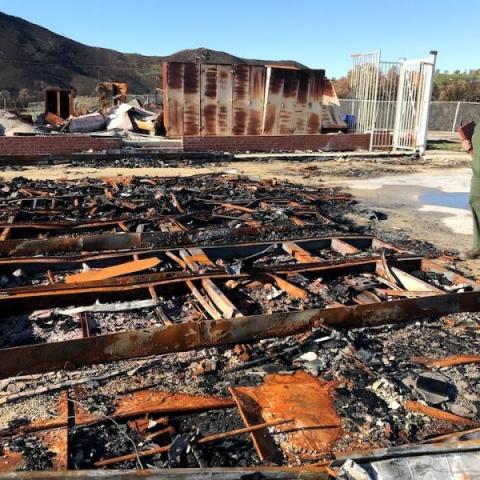
P-65, a female, is believed to be the first mountain lion to die from mange at Santa Monica Mountains NRA/NPS file
A female mountain lion who survived a dash across the 101 Freeway at Santa Monica Mountains National Recreation Area in California could not survive a bout with mange, according to park biologists.
P-65 is believed to be the first mountain lion in a two-decade-long National Park Service research study at the park to have died of complications from notoedric mange, a highly contagious skin disease caused by a mite parasite. She was found dead by biologists on March 4, 2022, near a stream in the central Santa Monica Mountains, where she lived. She was estimated to be around five years of age.
Her case of mange was severe, evidenced by hair loss and skin encrustation, especially on her face and head. She was also extremely emaciated, park staff said.
After death, she was taken to the California Animal Health and Food Safety Lab for a full necropsy and testing. Toxicological tests revealed that she was exposed to five different anticoagulant rodenticides, also known as rat poisons, and to bromethalin, a neurotoxic rodenticide. The five anticoagulant rodenticide compounds detected in P-65's liver -- brodifacoum, bromadiolone, difethialone, chlorophacinone, and diphacinone -- included both first-generation and longer-lasting and faster-acting second-generation compounds.
"We've had several radio-collared mountain lions that have contracted mange in the past, although in previous cases we were able to treat them with a topical anti-parasitic medicine," said Jeff Sikich, a wildlife biologist with the park who leads the fieldwork on the mountain lion project. "All of these animals recovered from their mange disease as best as we could tell from remote camera photos or later examination. However, in P-65's case, we did not know about her disease until after she had died."
Notoedric mange is a skin disease resulting from infection by mites in the genus Notoedres that affects wild cats such as bobcats and mountain lions, as well as other wildlife species including squirrels and rabbits.
Through long-term NPS research on bobcats in the Santa Monica Mountains and Simi Hills, notoedric mange was found to be a major source of mortality since it was first documented in late 2001. This research has shown a strong correlation between severe mange and the level of exposure to anticoagulant rodenticides, and through collaboration with colleagues at UCLA, AR exposure was associated with multiple impacts on bobcat immune systems at both physiological and genetic levels.
These impacts of toxicant exposure on an animal's immune system may in turn make them more susceptible to contracting mange disease. Mountain lions that biologists were able to test that have been documented with mange have also been exposed to ARs, although virtually every mountain lion tested overall has also been exposed. In mountain lions, six collared animals and seven animals overall have been documented to have died from the direct effects of the poisons, specifically bleeding to death internally after the toxicants prevented their blood from clotting.
Biologists say that P-65 was an interesting cat to study. She was first captured and collared in the central portion of the Santa Monica Mountains in March 2018. She survived the Woolsey Fire in November 2018, and based on her GPS locations her home range was found to be entirely within the overall burn perimeter, although during this time she largely used the southeast corner of the burn where there were some sizable, unburned islands.
In August 2019, P-65 became the second radio-collared female mountain lion to cross the 101 Freeway in the study’s history. She moved northward into the Simi Hills from the Liberty Canyon area of Agoura Hills, where the Wallis Annenberg Wildlife Crossing is currently under construction. Biologists believe P-65 most likely ran across the actual roadway. She eventually crossed the freeway again, returning to the central Santa Monica Mountains in the following weeks.
In the summer of 2020, P-65 gave birth to a litter of three kittens, P88, P89, and P90. Last year biologists captured the two remaining kittens -– males P-89 and P-90 -– to place GPS radio collars on them. Interestingly, both P-89 and P-90 had mange when captured. The two cats were both treated for mange, and remote camera photos later indicated that they had likely recovered. Unfortunately, both P-89 and P-90 were killed on local roads after dispersing from their mother. P-89 recently died on the 101 Freeway in Woodland Hills in July 2022 and P-90 died several weeks ago on Highway 33 just south of Ojai in Ventura County.
NPS has been studying mountain lions in and around the Santa Monica Mountains for the last two decades to determine how they survive in a fragmented and urbanized environment. CDFW is responsible for overseeing the management and conservation of mountain lions in the state.


 Support Essential Coverage of Essential Places
Support Essential Coverage of Essential Places







Comments
It would be difficult to argue that this was a natural death, and that the effects of man had no play in it. What a horrible thing to have happen.